Have you ever planted gladioli only to find yourself staring at green leaves while your neighbor’s garden bursts with colorful spikes? I’ve been there too, wondering why my timing seems off every single season.
The truth is, most gardeners plant gladioli once in spring and hope for the best. In reality, gladiolus plants respond better to a staggered schedule.
But here’s what changed everything for me: understanding that gladioli flowering isn’t just about when you plant, it’s about creating a strategic schedule that gives you blooms from July straight through to October. It also yields more reliable cut flowers for arrangements.
I’m going to show you exactly how to time your gladioli plantings so you’ll have continuous flowers all summer long. No more guesswork, no more disappointing gaps in your garden display.
Ready to change your gladioli game? Let’s start with the basics.
What Are Gladioli?
Gladioli are tall, sword-shaped flowering plants that belong to the iris family. These plants grow from underground bulbs called corms, a type of flower bulbs, and produce striking flower spikes that can reach up to 6 feet in height.
Native to South Africa and Mediterranean regions, gladioli—often called the sword lily—come in nearly every color except true blue. Their long, narrow leaves resemble swords, giving them their distinctive appearance.
These popular garden plants bloom in summer and create impressive vertical displays in flower beds and borders. Each stem supports a sequence of opening florets.
|
Key Characteristics
|
These plants are popular in gardens and as cut flowers. Their dramatic height and colorful blooms make them perfect for adding vertical interest to flower beds. Most gladioli bloom in summer and require full sun to thrive.
Getting your gladioli to bloom is just the beginning. With the right care techniques, you can enjoy flowers from July right through to October.
How to Grow Gladioli?
Growing gladioli successfully isn’t complicated, but following the right steps in the correct order makes the difference between disappointing results and spectacular flower displays.
Step 1: Choose Your Location
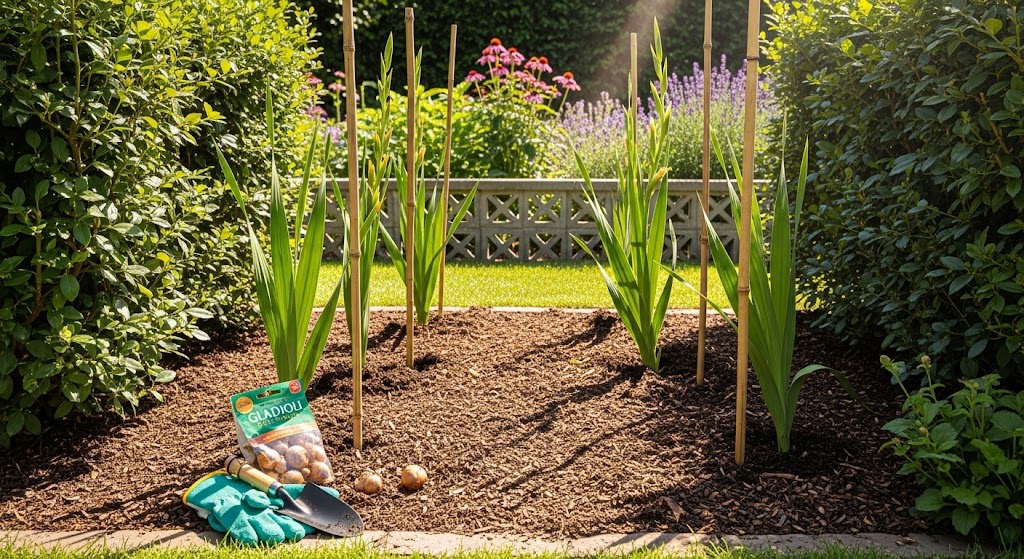
Select a sunny, well-drained spot that receives at least 6 hours of direct sunlight daily.
Avoid areas where water pools after rain, as gladioli corms will rot in waterlogged conditions. Pick locations sheltered from strong winds that could topple tall flower spikes.
Step 2: Prepare the Soil
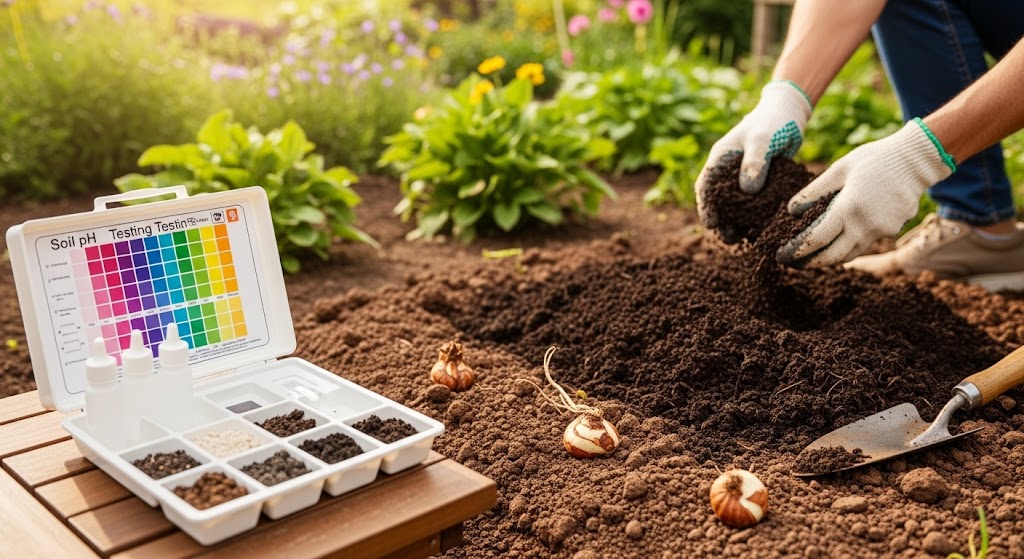
Test your soil pH using a simple garden test kit. Gladioli thrive in slightly acidic to neutral soil between 6.0-7.0. Add compost or well-rotted manure to heavy clay soils to improve drainage.
Work organic matter 20cm deep into the planting area several weeks before planting.
Step 3: Time Your Planting
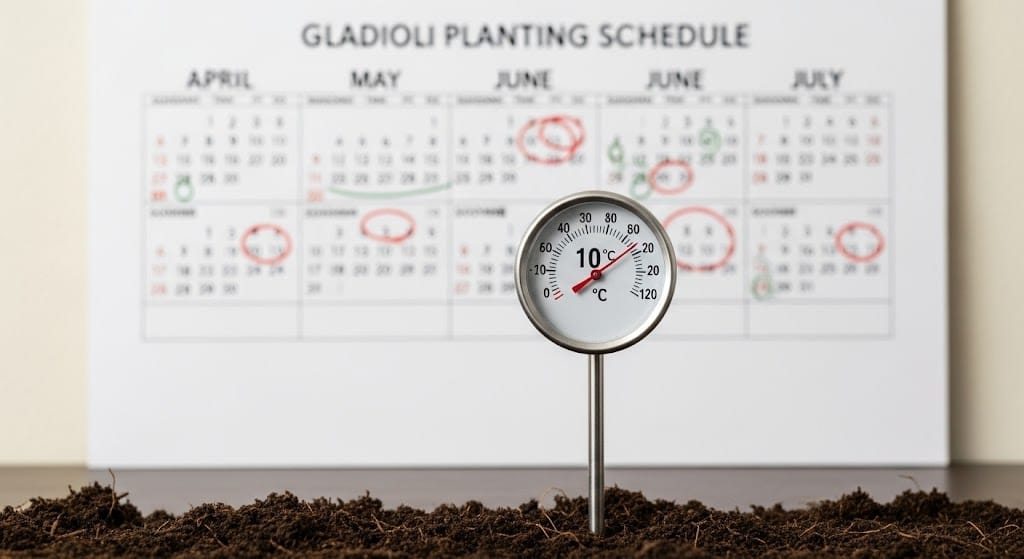
Wait until soil temperature consistently reaches 10°C (50°F) before planting your first batch of corms.
Check the weather forecast and avoid planting when late frosts are predicted. Plan to plant new batches every 2-3 weeks from April through July for continuous summer blooms.
Step 4: Plant the Corms

Dig planting holes 10-15cm deep, placing each corm with the pointed end facing upward and the flat base downward.
Space corms 15cm apart in all directions to allow proper air circulation. Cover with soil and firm gently, then water lightly to settle the soil around each corm.
Step 5: Provide Growing Season Care
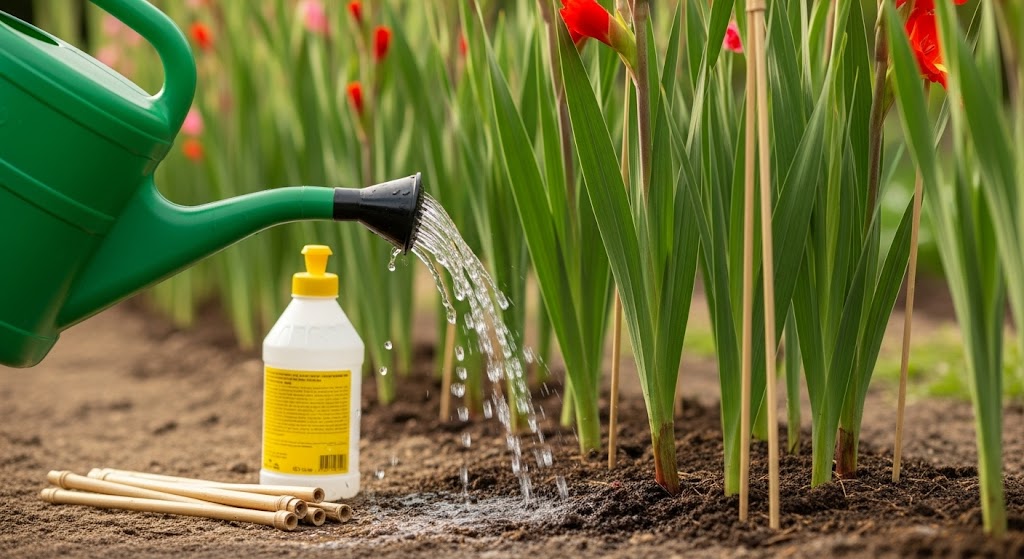
Water plants weekly at soil level during the growing season, avoiding wetting the leaves and flowers which can encourage fungal diseases.
Apply balanced liquid fertilizer every two weeks once green shoots emerge from the soil. Install stakes for tall varieties before they reach 30cm height.
Step 6: Monitor and Maintain
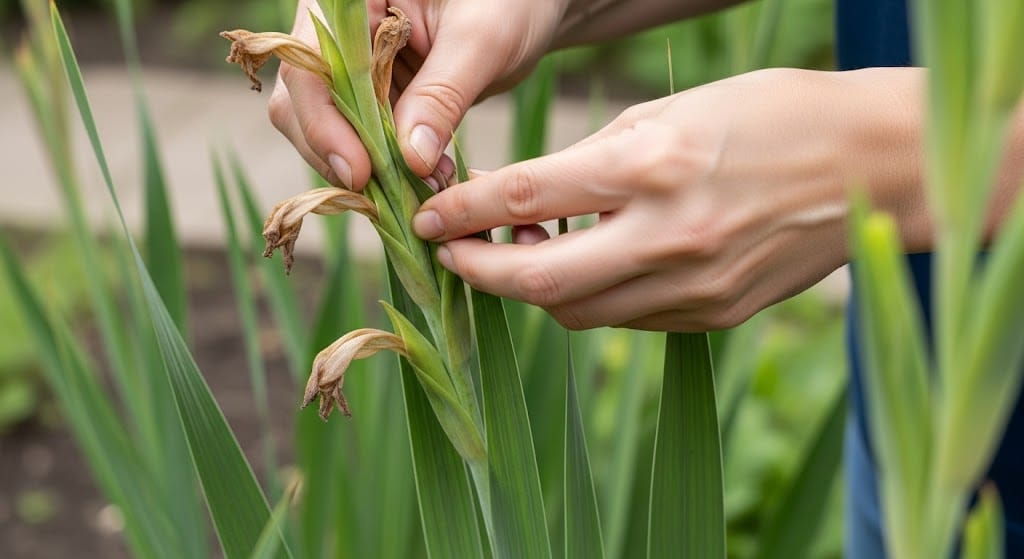
Remove spent flower heads regularly to encourage continued blooming, but leave all foliage intact until it naturally yellows and dies back.
Check plants weekly for pest problems like thrips or aphids. Maintain consistent moisture levels but reduce watering frequency after flowering finishes to prepare corms for dormancy.
Follow these six steps and you’ll have healthy gladioli blooming reliably every summer. Now let’s look at the specific timing that determines when your flowers will appear.
Optimal Planting and Timing for Maximum Blooming
Getting your gladioli timing right converts a basic flower bed into a showstopping display that keeps neighbors asking for your secrets. It’s the simplest way to stretch gladiolus flowers across the whole summer.
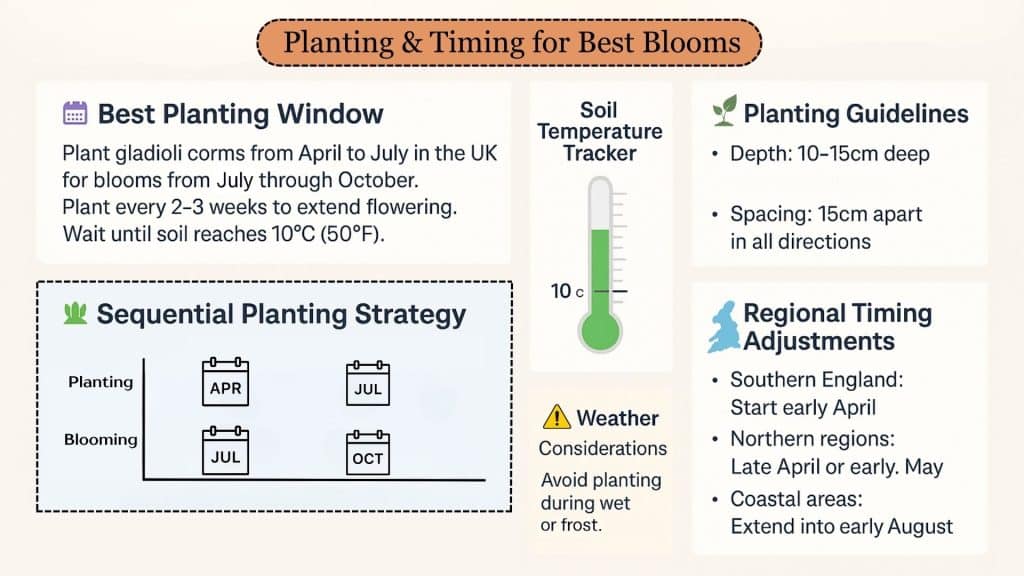
Getting your gladioli timing right changes a basic flower bed into a showstopping display that keeps neighbors asking for your secrets.
Factors That Influence Flowering
While timing your planting is important, several environmental and care factors can speed up or delay your gladioli’s flowering schedule.
Understanding these variables helps you predict bloom times more accurately and troubleshoot any delays in your garden display.
1. Temperature: Warmer soil speeds up growth while cold weather delays blooms. Gladioli need consistent temperatures above 10°C for proper development.
2. Sunlight exposure: Full sun locations produce earlier, stronger blooms. Shaded areas delay flowering by 2-3 weeks and create weaker stems.
3. Soil drainage: Well-drained soil prevents corm rot and promotes faster growth. Waterlogged conditions delay flowering and damage plant health significantly.
4. Planting depth: Correct depth (10-15cm) ensures proper root development. Shallow planting creates weak stems while deep planting delays emergence.
5. Variety selection: Early varieties bloom 70-80 days after planting. Late varieties take 90-100 days, affecting your garden’s flowering schedule.
6. Corm size: Larger corms produce earlier, bigger flower spikes. Small corms take longer to establish and may skip flowering completely.
By controlling these factors, you can fine-tune your gladioli’s performance and choose varieties that work best for your specific garden conditions.
Recommended UK Gladioli Varieties
Choosing the right varieties for UK conditions makes all the difference between disappointing results and spectacular displays. These proven performers thrive in British weather and offer reliable blooms throughout the season.
| Variety Name | Color | Height | Season | Special Features |
|---|---|---|---|---|
| Peter Pears | Salmon Pink | 120cm | Early | Classic UK favorite, reliable bloomer, excellent cut flower |
| White Prosperity | Pure White | 110cm | Mid | Weather resistant, strong stems, wedding favorite |
| Oscar | Deep Red | 130cm | Mid | Dramatic color, tall spikes, show garden winner |
| Amsterdam | Bright Red | 100cm | Early | Compact size, ideal for windy areas, long lasting |
| Princess Margaret Rose | Pink/Yellow | 115cm | Mid | Bicolor blooms, cottage garden style, fragrant |
| Yellowstone | Golden Yellow | 125cm | Late | Bright color, autumn bloomer, disease resistant |
| Blue Isle | Blue-Purple | 120cm | Mid | Unique color, cool climate adapted, striking display |
| Traderhorn | Scarlet Red | 140cm | Late | Giant flowers, exhibition quality, needs staking |
| Green Star | Cream/Green | 110cm | Early | Unusual color, florist choice, hardy variety |
| Purple Flora | Lavender | 105cm | Mid | Compact growth, border suitable, long flowering |
These varieties have proven themselves in UK gardens year after year. Start with 2-3 different types of gladiolus to see which performs best in your specific location and soil conditions.
Extending the Bloom Season & Aftercare
Getting your gladioli to bloom is just the beginning. With the right care techniques and planning strategies, you can enjoy continuous flowers from July right through to October while ensuring healthy corms for next year’s display.
- Succession Planting: Plant new corms every 2-3 weeks from April to July for continuous blooms throughout summer and early autumn.
- Regular Watering: Water at soil level weekly during the growing season. Avoid wetting flowers and leaves to prevent disease and damage.
- Autumn Lifting: Lift corms in October after foliage dies back. Clean off the soil and dry it completely in a warm, airy place.
- Winter Storage: Store dried corms in mesh bags in a cool, dry, frost-free location. Check monthly and remove any rotting corms.
- Feeding Schedule: Apply liquid fertilizer every 2 weeks during the flowering period. Stop feeding after blooms fade to prepare corms for dormancy.
Follow this aftercare routine and you’ll have healthy corms ready for planting next spring, creating a sustainable cycle of beautiful gladioli displays year after year.
Conclusion
Timing your gladioli plantings correctly changes your garden from a one-hit wonder into a continuous summer spectacle.
I’ve shown you how sequential planting from April to July creates blooms that last from midsummer until frost arrives.
The secret isn’t complicated – it’s about understanding that gladioli respond to soil temperature, sunlight, and proper spacing.
When you plant every 2-3 weeks and choose varieties suited to UK conditions, you guarantee months of colorful displays rather than brief moments of beauty.
Your gladioli timing strategy starts now. Pick your favorite varieties from the list I’ve shared, mark your calendar for regular plantings, and prepare for the most impressive flower display your garden has ever seen.
What’s your biggest challenge with gladioli timing?
Share your experiences in the comments below. I’d love to help solve your specific garden puzzle.
See more ideas and inspiration for flower lovers.














